Jammu–Baramulla line
| Jammu–Baramulla railway line | ||||||||||||||||||||||||||||||||||||||||||||||||||||||||||||||||||||||||||||||||||||||||||||||||||||||||||||||||||||||||||||||||||||||||||||||||||||||||||||||||||||||||||||||||||||||||||||||||||||||||||||||||||||||||||||||||||||||||||||||||||||||||||||||||||||||||||||
|---|---|---|---|---|---|---|---|---|---|---|---|---|---|---|---|---|---|---|---|---|---|---|---|---|---|---|---|---|---|---|---|---|---|---|---|---|---|---|---|---|---|---|---|---|---|---|---|---|---|---|---|---|---|---|---|---|---|---|---|---|---|---|---|---|---|---|---|---|---|---|---|---|---|---|---|---|---|---|---|---|---|---|---|---|---|---|---|---|---|---|---|---|---|---|---|---|---|---|---|---|---|---|---|---|---|---|---|---|---|---|---|---|---|---|---|---|---|---|---|---|---|---|---|---|---|---|---|---|---|---|---|---|---|---|---|---|---|---|---|---|---|---|---|---|---|---|---|---|---|---|---|---|---|---|---|---|---|---|---|---|---|---|---|---|---|---|---|---|---|---|---|---|---|---|---|---|---|---|---|---|---|---|---|---|---|---|---|---|---|---|---|---|---|---|---|---|---|---|---|---|---|---|---|---|---|---|---|---|---|---|---|---|---|---|---|---|---|---|---|---|---|---|---|---|---|---|---|---|---|---|---|---|---|---|---|---|---|---|---|---|---|---|---|---|---|---|---|---|---|---|---|---|---|---|---|---|---|---|---|---|---|---|---|---|---|---|---|---|
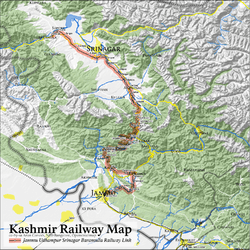 Map of the railway line | ||||||||||||||||||||||||||||||||||||||||||||||||||||||||||||||||||||||||||||||||||||||||||||||||||||||||||||||||||||||||||||||||||||||||||||||||||||||||||||||||||||||||||||||||||||||||||||||||||||||||||||||||||||||||||||||||||||||||||||||||||||||||||||||||||||||||||||
| Overview | ||||||||||||||||||||||||||||||||||||||||||||||||||||||||||||||||||||||||||||||||||||||||||||||||||||||||||||||||||||||||||||||||||||||||||||||||||||||||||||||||||||||||||||||||||||||||||||||||||||||||||||||||||||||||||||||||||||||||||||||||||||||||||||||||||||||||||||
| Locale | Jammu and Kashmir | |||||||||||||||||||||||||||||||||||||||||||||||||||||||||||||||||||||||||||||||||||||||||||||||||||||||||||||||||||||||||||||||||||||||||||||||||||||||||||||||||||||||||||||||||||||||||||||||||||||||||||||||||||||||||||||||||||||||||||||||||||||||||||||||||||||||||||
| Termini |
Jammu Tawi Baramulla | |||||||||||||||||||||||||||||||||||||||||||||||||||||||||||||||||||||||||||||||||||||||||||||||||||||||||||||||||||||||||||||||||||||||||||||||||||||||||||||||||||||||||||||||||||||||||||||||||||||||||||||||||||||||||||||||||||||||||||||||||||||||||||||||||||||||||||
| Operation | ||||||||||||||||||||||||||||||||||||||||||||||||||||||||||||||||||||||||||||||||||||||||||||||||||||||||||||||||||||||||||||||||||||||||||||||||||||||||||||||||||||||||||||||||||||||||||||||||||||||||||||||||||||||||||||||||||||||||||||||||||||||||||||||||||||||||||||
| Owner | Indian Railways | |||||||||||||||||||||||||||||||||||||||||||||||||||||||||||||||||||||||||||||||||||||||||||||||||||||||||||||||||||||||||||||||||||||||||||||||||||||||||||||||||||||||||||||||||||||||||||||||||||||||||||||||||||||||||||||||||||||||||||||||||||||||||||||||||||||||||||
| Operator(s) | Northern Railway zone | |||||||||||||||||||||||||||||||||||||||||||||||||||||||||||||||||||||||||||||||||||||||||||||||||||||||||||||||||||||||||||||||||||||||||||||||||||||||||||||||||||||||||||||||||||||||||||||||||||||||||||||||||||||||||||||||||||||||||||||||||||||||||||||||||||||||||||
| Technical | ||||||||||||||||||||||||||||||||||||||||||||||||||||||||||||||||||||||||||||||||||||||||||||||||||||||||||||||||||||||||||||||||||||||||||||||||||||||||||||||||||||||||||||||||||||||||||||||||||||||||||||||||||||||||||||||||||||||||||||||||||||||||||||||||||||||||||||
| Line length | 345 km (214 mi) | |||||||||||||||||||||||||||||||||||||||||||||||||||||||||||||||||||||||||||||||||||||||||||||||||||||||||||||||||||||||||||||||||||||||||||||||||||||||||||||||||||||||||||||||||||||||||||||||||||||||||||||||||||||||||||||||||||||||||||||||||||||||||||||||||||||||||||
| Number of tracks | 1 | |||||||||||||||||||||||||||||||||||||||||||||||||||||||||||||||||||||||||||||||||||||||||||||||||||||||||||||||||||||||||||||||||||||||||||||||||||||||||||||||||||||||||||||||||||||||||||||||||||||||||||||||||||||||||||||||||||||||||||||||||||||||||||||||||||||||||||
| Track gauge | 1,676 mm (5 ft 6 in) broad gauge | |||||||||||||||||||||||||||||||||||||||||||||||||||||||||||||||||||||||||||||||||||||||||||||||||||||||||||||||||||||||||||||||||||||||||||||||||||||||||||||||||||||||||||||||||||||||||||||||||||||||||||||||||||||||||||||||||||||||||||||||||||||||||||||||||||||||||||
| Highest elevation | 327–1,590 m (1,073–5,217 ft) | |||||||||||||||||||||||||||||||||||||||||||||||||||||||||||||||||||||||||||||||||||||||||||||||||||||||||||||||||||||||||||||||||||||||||||||||||||||||||||||||||||||||||||||||||||||||||||||||||||||||||||||||||||||||||||||||||||||||||||||||||||||||||||||||||||||||||||
| ||||||||||||||||||||||||||||||||||||||||||||||||||||||||||||||||||||||||||||||||||||||||||||||||||||||||||||||||||||||||||||||||||||||||||||||||||||||||||||||||||||||||||||||||||||||||||||||||||||||||||||||||||||||||||||||||||||||||||||||||||||||||||||||||||||||||||||
The Jammu–Baramulla railway line[1] is a railway track being laid to connect the Kashmir Valley in the Indian state of Jammu and Kashmir with Jammu railway station and thence to the rest of the country. The 345-kilometre (214 mi) railway track begins at Jammu and ends at Baramulla. It is in the jurisdiction of the Firozpur railway division of Indian Railways' Northern zone.
Construction of the route faced natural challenges including major earthquake zones, extreme temperatures and inhospitable terrain.[2] The project has had a long and chequered history, and serious progress was made only after it was declared a national project in 2002. Although its scheduled completion date was 15 August 2007, unforeseen complications have pushed back the date several times. The section from Jammu to Katra and Banihal to Baramulla has been built and is operational. The track from Katra to Banihal is to be completed by 2020.[3][4]
Timeline
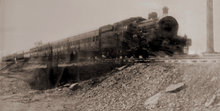
- 1897: The Jammu–Sialkot railway line is built from Sialkot to Jammu, the first rail line in the princely state of Jammu and Kashmir.
- 1902: Britain proposes a rail link following the Jhelum River, connecting Srinagar to Rawalpindi. The proposal is politically unpopular, since most of the state's residents live in Jammu and Srinagar (connected by the more-southerly Moghul road).
- 1905: Britain again proposes a link between Rawalpindi and Srinagar, and Maharaja Pratap Singh approves a rail line between Jammu and Srinagar via Reasi and the Moghul road. The line would have had 2 ft (610 mm) or 2 ft 6 in (762 mm)-gauge rail, climbing to the Moghul road pass at 11,000 feet (3,353 m) over the Pir Panjal Range (compare the present-day Pir Panjal Railway Tunnel [Banihal Rail Tunnel]'s average elevation of 1,760 metres (5,770 ft)). The electric line would have used mountain streams as a source of hydro-electric power. The narrow gauge and high-altitude pass would have made the line weather-dependent and restricted its speed and capacity, similar to the Darjeeling Himalayan Railway.
- 1947: With the partition of India, the Jammu-Sialkot line is closed and Jammu is disconnected from the Indian rail network; a new line from Pathankot to Jammu is needed. A proposed extension to Srinagar is dismissed as economically unfeasible after a preliminary survey of the Pir Panjal Range.
- 1983: Construction of a railway line from Jammu Tawi to Udhampur begins, with an optimistic schedule of five years and a budget of ₹500 million (US$7.0 million).[5]
- 1994: The railway minister declares the need for a rail line to Baramulla, and it is learned that it would run from Qazigund to Srinagar and on to Baramulla. A track from Katra to Qazigund through the mountains still appears unattainable.
- 2002: The government of India declares the railway line a national project, funded entirely by the government; its estimated cost is ₹60 billion (US$835.6 million).
- 2005: The 53-kilometre-long (33 mi) Jammu-Udhampur section opens in the Shivalik Hills, 21 years and ₹5.15 billion (US$71.7 million) after its beginning, the line's Leg 0.[6][7] The line has 20 major tunnels and 158 bridges. Its longest tunnel is 2.5 km (1.6 mi) and its highest bridge is 77 m (253 ft) (India's highest railway bridge).
- 2008: The Ministry of Railways cancels the project on the existing alignment between Katra and Qazigund due to suspected geological instability, ordering Konkan Railway to stop all work on the section (including the Chenab Bridge) and terminate all contracts issued for work on the section before major route changes.[8][9] The Railway Board appoints a committee to examine the feasibility of the project's Leg 2 and rework the Pir Panjal Range route,[10] proposing a fresh survey for a shorter line.[11] Leg 3's first, 66-kilometre (41 mi) section between Manzhama and Anantnag opens on 11 October, 14 months behind schedule, with twice-daily service in both directions. Complications continue to affect the connection with the plain.[12][13]
- 2009: On 14 February, Leg 3 service is extended to Baramulla.[14][15] In June, work on the section between Katra and Qazigund resumes after the committee approves the existing alignment with only minor changes.[16] Additional geotechnical tests of rock strata and changes to other portions of the alignment would be reviewed.[17] The 18-kilometre-long (11 mi) section from Anantnag to Qazigund is dedicated by the prime minister on 28 October, marking the completion of Leg 3.[18] A 1,676 mm (5 ft 6 in) broad gauge track from Baramulla to Kupwara is proposed, and railway minister K. H. Muniyappa tells Sharifud-Din Shariq during a late-year Lok Sabha session that its survey has been completed.[19] However, the line is excluded from the railway budget.[20]
- 2010: In December, Indian Railways completes a crucial tunnel in Sangaldam between Katra and Qazigund.[21]
- 2011-12: Boring of the 11.215 km (7 mile) long Banihal-Qazigund tunnel, connecting Banihal's Bichleri Valley with Qazigund, is completed in October 2011. Tracks are laid during the following year, and a trial run begins on 28 December 2012.[22] Eight years after the contract to design and build the world's tallest rail bridge was awarded to Afcons Infrastructure Limited, excavation of the foundations of the 1,315-metre-long (4,314 ft) bridge across the Chenab River begins.[23] The construction of all tunnels between Udhampur and Katra, including the T1 Tunnel which had seepage problem, was completed.[24] The Katra railway station is scheduled to open by March 2013.[25]
- 2013: The Pir Panjal Railway Tunnel and Banihal station open. On 9 December, a trial train reaches Katra.
- 2014: On 11 June, a trial train from Delhi arrives before the opening of the Udhampur-Katra line and the Katra station.[26] On 4 July, the Udhampur-Katra line opens.
Sections
The railway line is divided into four sections:[2]
- Leg 0, running 53 km (33 mi) from Jammu to Udhampur and completed in April 2005.[6]
- Leg 1, running 25 km (16 mi) from Udhampur to Katra. The section was dedicated on 4 July 2014
- Leg 2, running 148 km (92 mi) from Katra to Banihal. Under construction, it may open in 2021.[27]
- Leg 3 running 112 km (70 mi) from Banihal to Baramulla and originally expected to open in October 2009.[18] The line from Baramulla to the Banihal tunnel is 119 kilometres (74 mi) long.
Progress
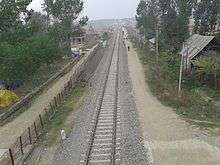
Leg 0 has been open since 2005, and Leg 1 has been operational since July 2014. The leg had missed opening dates in the past, including December 2005, December 2006[28] and May 2009.[29] Work on the section, suspended for two years due to a partial tunnel collapse, resumed in September 2009.[30] Although the section was planned to open by 2 February 2014, passenger service was delayed due to Commission of Railway Safety concerns about one bridge and tunnel. The route includes seven tunnels and 30 bridges.[31] The section was dedicated to the nation on 4 July 2014 by Prime Minister Narendra Modi.
Leg 2, under construction, may be completed in 2021. Construction on the leg has been beset by technical difficulties with alignment and disputes with contractors,[17] and was originally expected to be finished in 2017-18.[32][33][34][35] This is the line's most difficult section of the rail line, with 62 bridges and a number of tunnels totaling 10 km (6.2 mi) out of total 129 kilometres (80 mi). It requires 262 kilometres (163 mi) of access roads connecting 147,000 people in 73 villages; 160 kilometres (99 mi), connecting 29 villages, is completed.[36] In July 2008, work on part of the Katra-Banihal section was suspended for a possible realignment.[37] The alternative alignment, proposed by the railway, reduced the track length from 126 to 67 kilometres (78 to 42 mi). A committee appointed by the Railway Board recommended abandoning 93 kilometres (58 mi) of the previously-approved alignment.[38] On 12 November 2014, the Delhi High Court directed the central government to appoint a committee to review the 126-kilometre-long (78 mi) section.[39]
An 18-kilometre (11 mi) stretch of Leg 2, between Quazigund and Banihal, was authorized on 26 June 2013.[40] The stretch includes the 11.215-km (7-mile) Pir Panjal Railway Tunnel, also known as the Banihal railway tunnel. India's longest rail tunnel, it is 8.4 metres (28 ft) wide and 7.39 metres (24.2 ft)high. The tunnel includes a 3-metre-wide (9.8 ft) service road for maintenance and emergency use. Its average elevation, 1,760 m (5,770 ft), is 440 m (1,440 ft) below the existing road tunnel.[36]
The tunnel facilitates transportation during winter (when inclement weather closes the Srinagar-Jammu highway), and halves the distance between Quazigund and Banihal (35 km or 22 mi by road and 17.5 km or 10.9 mi by train).[41] The Banihal railway station is 1,702 m (5,584 ft) above mean sea level, and trains run from Banihal to Qazigund through the tunnel. The 5-kilometre (3.1 mi) Banganga section was expected to be operational before the completion date of 2017-18 for the entire project.[42]
Leg 3 has been operational since October 2009. The line from Baramulla to Banihal, across the Pir Panjal Range, is 130 kilometres (81 mi) long. Since the 25-kilometre-long (16 mi) Udhampur-Katra section was commissioned in October 2013, only the 148-kilometre (92 mi) Katra-Banihal section of Leg 2 remains to be constructed. Until the Katra-Laole section of railway is finished by 2020, travel from Jammu Tawi (or Udhampur) to Banihal by road and from Banihal to Srinagar by rail is possible.
Infrastructure and construction
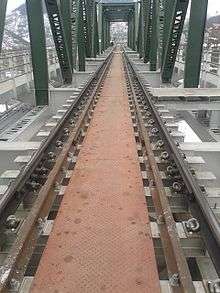
The line may be the most difficult rail project undertaken on the Indian subcontinent. The young Himalayas are geologically surprising and problematic.[2] The track's alignment presents one of the greatest railway engineering challenges ever faced; only Tibet's Qingzang Railway, completed in 2006 across permafrost and climbing to over 5,000 m (16,000 ft) above sea level, is comparable. Although the Indian temperatures are less severe, the region experiences harsh winters with heavy snowfall. In the Pir Panjal Range, most peaks exceed 15,000 ft (4,600 m) in height.
The route includes many bridges, viaducts and tunnels. The railway is expected to cross over 750 bridges and pass through over 100 km (62 mi) of tunnels, the longest of which is 11,215 m (6.969 mi).[2] Engineering challenges include crossing the Chenab River river on a 1,315-metre-long (4,314 ft) bridge 359 m (1,178 ft) above the riverbed and crossing the Anji Khad on a 657-metre-long (2,156 ft) bridge 186 m (610 ft) above the riverbed.[43] The Chenab Bridge will be the highest railway structure of its kind in the world, 35 metres (115 ft) higher than the top of the Eiffel Tower. Both bridges will be simple. Weathering steel is planned for an environmentally-friendly appearance and to eliminate the need for painting. The design and structure is similar to West Virginia's New River Gorge Bridge. The project is managed by the Konkan Railway Corporation. Completion was scheduled for 2012 (four years after the first isolated section of the route was opened for local passenger service), and it requires 26,000 tonnes of steel.
All tunnels are built with the New Austrian tunnelling method, and a number of challenges have been encountered while tunneling through the geologically-young, unstable Sivalik Hills. In particular, water entered the Udhampur-to-Katra section; this required drastic solutions with steel arches and several feet of shotcrete.
Although the rail line is being built through a mountainous region, a one-percent ruling gradient has been set to provide a safe, smooth, reliable journey. Bank engines will not be required, making the journey quicker and smoother. It will use 1,676 mm (5 ft 6 in) Indian broad gauge continuous welded rail laid on concrete sleepers, with a minimum curve radius of 676 m. The maximum speed will be 100 kilometres per hour (62 mph).[2] Provision for future doubling will be made on major bridges. Provisions for future electrification will also be made, although the rail line will use diesel locomotives initially; the region is presently electricity-scarce. There will be 30 stations on the route, initially served by 10–12 trains per day.
Rolling stock
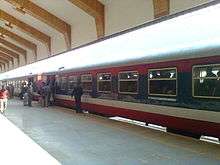
Passenger service will be provided by high-power diesel multiple units and heated, air-conditioned coaches have wide windows, sliding doors and reclining seats. The driver's cabin has a heating and defogging unit, and is fitted with a one-piece glass window for a wider view. A snow-cutting cattle guard is attached to the front of the train to clear snow from the tracks during winter. Due to the valley's cold climate, the 1,400-horsepower diesel engine has a heating system for quick, trouble-free starts. Coaches have a public-information system (display and announcements) and a pneumatic suspension for riding comfort. There is a compartment for the physically disabled, with wider doors.[44]
Freight rolling stock for the route will come from the existing national fleet. Freight service (grain and petroleum products) will run between the 10–12 daily passenger trains. Maintenance will be done at the Badgam workshop, north of Srinagar. Three-aspect colour-light signalling is being installed on the route for safety, and GSM-R equipment may be installed in the future to improve its quality.
Project agencies
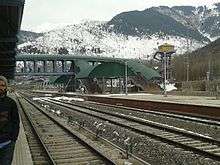
Indian Railways is in charge of the 25-kilometre (16 mi) Udhampur-Katra section. The subsidiary Konkan Railway Corporation is in charge of the 90-kilometre (56 mi) Katra-Laole section. This is arguably the line's most difficult portion, with over 92 percent tunnels or bridges—12 kilometres (7.5 mi) of bridges and 72 kilometres (45 mi) of tunnels. Ircon International, a public-sector company, is in charge of the 175-kilometre (109 mi) Dharam-Qazigund-Baramulla section. One hundred thirty-eight kilometres of the line, including the valley and the Pir Panjal Railway Tunnel, is operational. Hindustan Construction Company built the 11,215 m (6.969 mi) Pir Panjal tunnel through the range for about US$120 million.[45] Afcons Infrastructure Limited and South Korea's Ultra Engineering will design and build the Chenab Bridge for $130 million.[46] Gammon India and South Africa's Archirodon Construction will build the Anji Khad Bridge for $100 million.
Security
The rail line's security has been a major concern as it passes through areas with a potential for terrorism.[47] Closed-circuit television cameras at major bridges, tunnels and stations are planned, and all major bridges and tunnels are illuminated.
Construction-related casualties
- June 2004 – Ircon International engineer Sudhir Kumar Pundir and his brother Sanjay were kidnapped and murdered by unidentified assailants, possibly for ransom, in Zainapora, Pulwama.[48]
- June 2005 – Altaf Hussain, a Hindustan Construction Company (HCC) labourer, was killed by a tunnel collapse in Tathyar; two others were injured.
- 16 May 2007 – Two girls, ages nine and seven, drowned in a rail company ditch.
- 14 Feb 2008 – A Nepali labourer Tika Ram Balwari was killed after being struck by a boulder in Uri Varmul.
- 18 Apr 2008 – Six labourers in the Katra-Qazigund project were killed and two others were injured when the dump truck in which they were riding rolled into a deep gorge in Lower Juda Morh (near Kouri in Reasi district) late at night.[49]
- 27 Mar 2011 – Two workers, Abdul Rahman (age 34) and Jumma Baksh (24), were killed at a railway bridge under construction over the Chenab River in Reasi district when the basket in which they were riding (attached to a crane) unhooked and fell over 100 metres.[50]
See also
References
- ↑ "Jammu-Baramulla line". Railway Technology.
- 1 2 3 4 5 Harish Kunwar. "Train-Link for J & K Prosperity". Press Release, Press Information Bureau, Government of India, dated 2008-10-16. Retrieved 25 November 2008.
- ↑ "Kashmir Rail Link to be Completed by 2020. Will Have World's Highest Railway Bridge". NDTV.com. 4 July 2015.
- ↑ "Kashmir rail link project to be completed by 2020: Railway officials". The Times of India.
- ↑ Arun Sharma (10 October 1998). "Destination nowhere". Indian Express. Archived from the original on 18 March 2012. Retrieved 14 August 2008.
- 1 2 Harsh Bhal (13 April 2005). "A landmark development: Jammu-Udhampur rail line". Press Release, Press Information Bureau, Government of India. Retrieved 13 August 2008.
- ↑ S.P. Sharma & Tripti Nath. "Manmohan flags off first Udhampur-Jammu train". Online Edition of The Tribune, dated 2005-04-14. Retrieved 13 August 2008.
- ↑ Raghvendra Rao. "No full stops in this train journey". Online edition of The Indian Express, dated 2008-08-07. Archived from the original on 10 August 2008. Retrieved 10 August 2008.
- ↑ Manoj Mitta (18 September 2008). "With Chenab project scrapped, Rs 450 cr may go waste". Online edition of The Times of India, dated 2008-09-18. Retrieved 18 September 2008.
- ↑ Manoj Mitta (26 October 2008). "Course correction saves Kashmir train". Online edition of The Times of India, dated 2008-10-26. Retrieved 15 December 2008.
- ↑ Manoj Mitta (12 September 2008). "India drops plans for world's highest bridge". Online edition of The Times of India, dated 2008-09-12. Retrieved 23 September 2008.
- ↑ "Manmohan flags off first train in Kashmir Valley". Online edition of The Hindu, dated 2008-10-12. Chennai, India. 12 October 2008. Archived from the original on 7 July 2009. Retrieved 12 October 2008.
- ↑ "Prime Minister flags off Kashmir Valley's dream train". India Today. 11 October 2008.
- ↑ "Valley train reaches Baramulla".
- ↑ PTI (14 February 2009). "Train between Baramulla, Anantnag to be flagged off today". Online edition of The Hindu, dated 2009-02-14. Chennai, India. Archived from the original on 7 July 2009.
- ↑ Amba Batra Bakshi. "Bogey Rolls Out". Online edition of Outlook India, dated 2009-06-08. Archived from the original on 31 January 2013. Retrieved 1 June 2009.
- 1 2 Raghvendra Rao. "Rly crosses the Chenab 'bridge', to resume work". Online edition of Indian Express, dated 2009-06-23. Retrieved 23 June 2009.
- 1 2 "Prime Minister dedicates Anantnag-Quazigund rail line in Kashmir to nation". Press Release, Press Information Bureau, Government of India. 28 October 2009. Retrieved 2 December 2009.
- ↑ "Questions asked by Mr. Sharifud-Din Shariq during Lok Sabha session November - December 2009".
- ↑ "Archived copy". Archived from the original on 4 January 2014. Retrieved 3 January 2014.
- ↑ "Railways complete construction of crucial tunnel in Kashmir". Indian Express. New Delhi, India. 4 December 2010.
- ↑ http://www.hindustantimes.com/India-news/Srinagar/Country-s-longest-rail-tunnel-opens-to-trial-in-Valley/Article1-981770.aspx%5Bpermanent+dead+link%5D
- ↑ http://pugodesk.winwinhosting.net/dailyexcelsior/excavation-for-foundation-of-worlds-tallest-rly-bridge-begins/%5Bpermanent+dead+link%5D
- ↑ "Archived copy". Archived from the original on 29 November 2012. Retrieved 11 December 2012.
- ↑ Press Trust of India (27 November 2012). "Katra railway station to be commissioned by March".
- ↑ "Railways conduct trial run of Udhampur-Katra train".
- ↑ bureau, Odisha Diary (29 June 2017). "Minister of Railways Lays The Foundation Stone For Five New Halt Stations Between Quazigund-Baramulla - OdishaDiary". orissadiary.com.
- ↑ "Inauguration of Udhampur-Katra rail line delayed by a year".
- ↑ "Katra to be linked by rail line by May next year". Online edition of the Times of India, dated 2008-01-12. 12 January 2008. Retrieved 26 November 2008.
- ↑ Jupinderjit Singh (4 August 2009). "Work on Udhampur-Katra rail project to begin in Sept". The Tribune. Retrieved 12 December 2009.
- ↑ "J&K: Trains to go up to Katra from February - The Times of India". The Times of India.
- ↑ "jk-rail-line-to-be-operational-by-2017". The Times of India. 25 February 2011.
- ↑ "Indian railways to chug into Kashmir by 2017".
- ↑ "Connecting Kashmir Valley To India Via India's Longest Rail Tunnel". Archived from the original on 3 June 2011.
- ↑ Suryamurthy, R. (30 May 2011). "Rail sees Valley link by end 2012". The Telegraph. Calcutta, India.
- 1 2 "Welcome to Northern Railway Construction Organization (USBRL Project), INDIA".
- ↑ Press Trust of India (25 November 2014). "PAC blames Railways for Rs 3,258 cr loss in Kashmir project".
- ↑ "Kashmir's missing link". The Times of India.
- ↑ Press Trust of India (12 November 2014). "Katra-Banihal rail link: HC directs Centre to form committee".
- ↑ "PM, Sonia flag off train connecting Banihal in Jammu and Qazigund in Kashmir - The Times of India". The Times of India.
- ↑ "Indian Railways makes history, runs train through Asia's second longest tunnel".
- ↑ "Archived copy" (PDF). Archived (PDF) from the original on 4 March 2016. Retrieved 2 July 2013.
- ↑ "Salient Design Features of the Chenab and Anji Khad bridges" (PDF). Official webpage of the Konkan Railway Corporation Limited. Archived from the original (PDF) on 8 December 2003. Retrieved 14 August 2008.
- ↑ "History and hope ride on Kashmir's hi-tech train". Online edition of the Economic Times, dated 2008-10-11. 11 October 2008. Retrieved 11 December 2008.
- ↑ "UDHAMPUR-SRINAGAR-BARAMULLA NEW B.G. RAILWAY LINE PROJECT:PIR PANJAR TUNNEL (ZONE VA and VB)". Official webpage of HCC. Archived from the original on 26 October 2007. Retrieved 2 December 2008.
- ↑ "Bridges, Flyovers and Viaducts". Official webpage of AFCONS. Archived from the original on 8 July 2008. Retrieved 23 September 2008.
- ↑ Arun Joshi. "At Trouble Junction". Online edition of the Hindustan Times, dated 2008-06-10. Archived from the original on 5 July 2009. Retrieved 25 November 2008.
- ↑ "IRCON engineer, brother killed; bodies found". Retrieved 13 August 2008.
- ↑ "Six labourers killed, 2 hurt in Reasi mishap". Online edition of The Tribune, dated 2008-04-18. Retrieved 16 May 2011.
- ↑ "2 killed at rail project site". Online edition of The Tribune, dated 2011-03-27. Retrieved 13 August 2011.